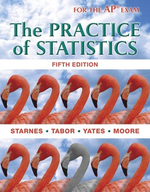Solution Found!
Light intensity In a physics class, the intensity of a 100-watt lightbulb was measured
Chapter 12, Problem R12.5(choose chapter or problem)
Light intensity In a physics class, the intensity of a 100-watt lightbulb was measured by a sensor at various distances from the light source. A scatterplot of the data is shown below. Note that a candela is a unit of luminous intensity in the International System of Units. Physics textbooks suggest that the relationship between light intensity y and distance x should follow an inverse square law, that is, a power law model of the form y = ax2 = a 1 x2. We transformed the distance measurements by squaring them and then taking their reciprocals. Some computer output and a residual plot from a least-squares regression analysis on the transformed data are shown below. Note that the horizontal axis on the residual plot displays predicted light intensity. Predictor Coef SE Coef T P Constant -0.000595 0.001821 -0.33 0.751 Distance^(-2) 0.299624 0.003237 92.56 0.000 S = 0.00248369 R-Sq = 99.9% R-Sq(adj) = 99.9% (a) Did this transformation achieve linearity? Give appropriate evidence to justify your answer. (b) What is the equation of the least-squares regression line? Define any variables you use. (c) What would you predict for the intensity of a 100-watt bulb at a distance of 2.1 meters? Show your work. R12
Questions & Answers
QUESTION:
Light intensity In a physics class, the intensity of a 100-watt lightbulb was measured by a sensor at various distances from the light source. A scatterplot of the data is shown below. Note that a candela is a unit of luminous intensity in the International System of Units. Physics textbooks suggest that the relationship between light intensity y and distance x should follow an inverse square law, that is, a power law model of the form y = ax2 = a 1 x2. We transformed the distance measurements by squaring them and then taking their reciprocals. Some computer output and a residual plot from a least-squares regression analysis on the transformed data are shown below. Note that the horizontal axis on the residual plot displays predicted light intensity. Predictor Coef SE Coef T P Constant -0.000595 0.001821 -0.33 0.751 Distance^(-2) 0.299624 0.003237 92.56 0.000 S = 0.00248369 R-Sq = 99.9% R-Sq(adj) = 99.9% (a) Did this transformation achieve linearity? Give appropriate evidence to justify your answer. (b) What is the equation of the least-squares regression line? Define any variables you use. (c) What would you predict for the intensity of a 100-watt bulb at a distance of 2.1 meters? Show your work. R12
ANSWER:Step 1 of 5
Given,
The relationship between light intensity y and distance x,
Also given that distance measurements were squared and then their reciprocals were taken. Using the computer output and a residual plot from a least-squares regression analysis on the transformed data were the horizontal axis on the residual plot displays predicted light intensity we have to determine the following:
